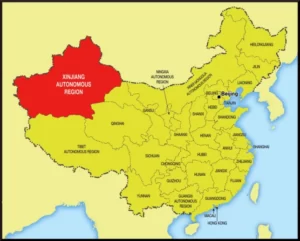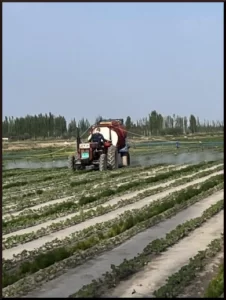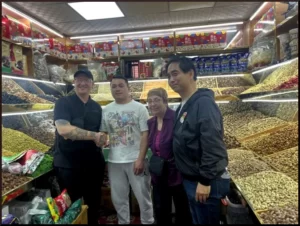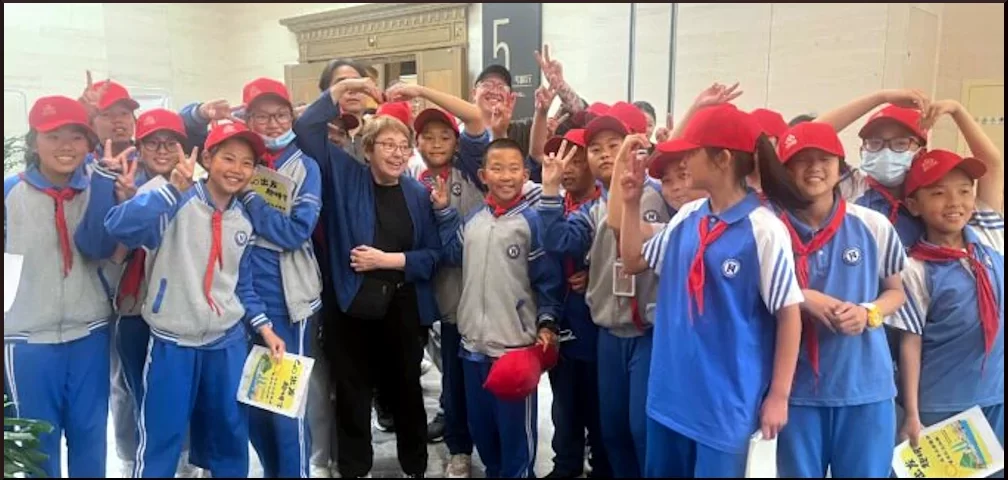by Sara Flounders, published on Workers World, June 9, 2023
Xinjiang, People’s Republic of China
U.S. propaganda is powerful. Responding to an increase in U.S. attacks on China, a delegation was organized by the China / U.S. Solidarity Network, which then visited China from May 11 to May 31.
One focus of the trip was a visit to Xinjiang (pronounced Shinjaang) province to gather video footage and interviews that give a more realistic picture of this vast and quickly modernizing, multiethnic region. Footage for the documentary, currently named “Voice of Xinjiang,” focuses on an area with 4,000 years of history, which is at the center of the ancient Silk Road that today is a major hub in China’s ambitious Belt and Road trade program.
The Xinjiang Uygur Autonomous Region (XUAR) is a vast arid, mountainous and high-desert region in China’s far northwest. Xinjiang has significant oil and mineral reserves and is currently China’s largest natural gas-producing region. The province — although the largest in geographic area, covering one-sixth of China’s total land mass — is sparsely populated, having only 2% of China’s 1.4 billion population. Of Xinjiang’s population of 25 million, 60% belong to 13 ethnic minorities.
The two major cities we visited — Urumqi and Kashgar — are over 1,000 miles from one another. The surrounding fully mechanized farms were part of our visit.

These cities are part of the “Silk Road,” the great historic trade route that connects Eastern Asia to Central and South Asia, the Middle East and Europe. Xinjiang has vital and strategic international importance. It borders eight countries: Kazakhstan, Kyrgyzstan, Tajikistan, Russia, the Republic of Mongolia, India, Pakistan and Afghanistan. Within China, it shares borders with three autonomous province/regions: Gansu, Qinghai and Tibet.
Today the population is actively learning new high-tech skills, which play a pivotal role in Xinjiang’s industrial development and its expanded commercial networks of high-speed trains and communications, which reach countries throughout Asia and into Europe and Africa.
Vibrant communities, zero ‘slave labor’
Torrents of U.S. media reports had told us to expect cities under martial law, military forces of occupation and heavily armed police on every corner. The Indigenous population, especially the Uygur people, are described as an impoverished and isolated population, who are allegedly forced into slave labor and doing backbreaking work in the fields or being locked inside concentration camps.
Coming from the New York City area, I expected a police force of at least equal size. The New York City police force is the world’s eighth-largest armed body. On our return, reports of “Stop and Frisk” programs centered on Black and Brown youth dominated the media: “Too many people in New York City are stopped, searched and frisked illegally, federal monitor says.” (abc7ny.com)
What we saw in Xinjiang was vibrant cities — Kashgar and Urumqi — full of tens of thousands of tourists, along with the local population of many nationalities. Huge and colorful marketplaces and bazaars, almost all of them run by Uygur families, stretched for many blocks. Busy subway lines crossed the cities. Everywhere we saw food markets brimming with inexpensive produce. Restaurants, cafes and street food stalls were packed with local people. In the evenings, the streets were full — not silent and ominous.
Our observations are backed up by numerous international studies that are ignored in the Western media.
The illiteracy rate in Xinjiang has fallen to 2.66%, lower than the country’s impressive 2.85% national average. At the time of the 1949 Chinese Revolution, illiteracy was 80% throughout China and more than 90% in Tibet and Xinjiang. Today 97.51% of small children are in preschool programs. Some 98.82% of the youth are enrolled in senior high schools in Xinjiang. (tinyurl.com/bdfyxn29)
A useful study of the area’s health and education achievements, as of 2022, can be found on the website of the South Asia Journal at “Excellent Xinjiang Health, Growth & Education Outcomes Contradict Sinophobic U.S. Lies.” (southasiajournal.net, Jan. 22, 2022)

Drives through the countryside revealed fully mechanized agriculture with tractors, planters, drone sprayers, irrigation canals and acres of plastic-topped greenhouses. We did not see any fields with workers doing hand labor of hoeing, picking and trimming. This is confirmed in numerous reports and many photos. The mechanization of cotton production is at 90%. (tinyurl.com/37s3e7e9)
In Kashgar, the 15th-century Idkah Mosque can house up to 20,000 worshipers. It is only one of the numerous Islamic centers and mosques, which we saw while walking the city streets and in several villages. Tall, slender minarets and dome-shaped roofs seemed to be a part of every block.
The narrative that China is destroying mosques and Islamic centers is continually pushed in the U.S. and Western media. It is regularly countered, however, by representatives from Muslim countries.
Arab and Muslim countries don’t agree with U.S. coverage
On April 27, 2021, the China Global Television Network English-language program “The Point with Liu Xin” interviewed ambassadors from Pakistan, Palestine and Syria, after they had made extensive visits to Xinjiang. They accused Western media of intentionally overlooking “the economic, social and cultural rights that Muslim Uygurs and other ethnic minorities enjoy in the region.”
Palestinian ambassador to China, Fariz Mehdawi said: “You know, the average of mosques, if you have to calculate it all, it’s something like 2,000 inhabitants for one mosque. This ratio, we don’t have it in our country. It’s not available anywhere.” (tinyurl.com/2w5mjdww)
The ambassadors praised the setting up of industries and advanced agriculture, poverty alleviation programs, a focus on education and health, and people-centered policies throughout Xinjiang. Their commentary aligns with what we saw on our visit.
No Arab or Muslim countries have joined in the U.S. rewriting of history and its targeted attacks on China. This is because these countries know that the U.S. government is responsible for 30 years of massively disruptive wars, sanctions, drone attacks and targeted assassinations in a series of Muslim countries, including Iraq, Iran, Lebanon, Libya, Syria, Sudan, Somalia and Afghanistan.
They know that more than 2.2 million people are incarcerated in the U.S., the largest prison population in the world, and the history of systematic genocide of Indigenous nations in the U.S. is well-known around the world. The U.S. claim that it is a protector of the Muslim population of China’s Xinjiang province reeks of racist hypocrisy.
Just before the COVID-19 shutdown of world travel in 2019, the Council of Foreign Ministers under the Organization of Islamic Cooperation (OIC), with 57 member states one of the largest intergovernmental bodies in the world, had endorsed and commended China’s treatment of its Muslim citizens, following a fact-finding trip to the region. (hongkongfp.com, March 3, 2019)
A week after our trip to Xinjiang, a large delegation from the League of Arab States, including top official representatives from more than 16 Arab/Muslim countries, went to many of the same sites we had visited. Egypt, Bahrain, Algeria, Djibouti, Saudi Arabia, Sudan, Syria, Somalia, Iraq, Oman, Comoros, Lebanon, Libya, Morocco, Mauritania and Palestine were represented, along with several departments of the Arab League and the China-Arab States Cooperation Forum.
Their June 1 press statement, released by the Embassy of China in Syria, described the top-level delegation’s findings. The statement said: “Through visits to Urumqi, Kashgar and other places, we saw social harmony, economic development, people of all ethnic groups living in harmony in Xinjiang and accelerated progress in various undertakings. We truly understood the truth about the development of Xinjiang and recognized the true purpose of some international forces to smear and even demonize Xinjiang.”
Charge of ‘genocide’ to justify U.S. sanctions
The U.S. corporate media, U.S. major think tanks and strategists have labeled this modernization of Xinjiang “genocide.” The schools, universities and vocational training centers are labeled “concentration camps.” Based on these fabricated charges, intense new sanctions have been rammed through the U.S. Congress against all products and goods coming from the Xinjiang region. U.S. sanctions will impact all of China’s cotton exports.
China is the world’s largest exporter of cotton, and before the sanctions legislation, the U.S. was the largest importer of China’s cotton. All commodities using lithium, nickel manganese, beryllium, copper and gold mined in Xinjiang will also be impacted by U.S. sanctions. These include the manufacture of solar panels, electric vehicles made by auto companies and other products from chip makers, electronics and energy firms.
The only support for the wild, unsubstantiated charges used to justify new rounds of U.S. sanctions has come from the G7 imperialist countries and their allies.

Amnesty International, Human Rights Watch, NPR, Radio Free Asia and other U.S.-funded “human rights” and news organizations unanimously claim that the government of China has carried out “massive and systematic abuse” against Muslims living in the Xinjiang Uygur Autonomous Region. Their reports of “forced labor” and religious and cultural suppression are uncritically and widely circulated by the Western corporate media. These reports were preparation for new rounds of harsher sanctions against Chinese exports.
First signed by President Joe Biden in December 2021, the “Uyghur Forced Labor Prevention Act” took effect June 23, 2022. Under this latest anti-China measure, all goods made in Xinjiang province are banned, unless the importer can demonstrate the imports were produced “free of forced labor.” (New York Times, April 8, 2022)
This latest U.S. anti-China propaganda campaign is based on unsubstantiated claims that Uygur people have been forced to take up new jobs in industries recently relocated to Xinjiang.
Welcome changes for farmers and herders
We visited Toltay Farm, outside of Kashgar, the home of an extended family, who had for generations been forced to constantly migrate with their herds of cattle, sheep and camels to find forage in an arid land. They are now able to live stable lives, due to new animal husbandry and farming techniques and government subsidies for new equipment.
They now use the crushed fodder that is extracted from a wide variety of farm products. It is grown on irrigated land, crisscrossed with a network of government-built canals. There are acres of greenhouses topped with plastic. The family proudly showed us their herds, now fattening in pens. With the assistance of technology, local herders can watch over their herds and monitor their health by checking their smart phones. (tinyurl.com/ydmyjzha)
At a local primary school, teachers explained that classes were held in Uygur and Mandarin.
The state farm has been divided into lots, with some families choosing to farm cotton, vegetables or wheat, while others focus on raising animals. We visited families who leased out their land while they trained in construction or as mechanics and equipment operators. Other families were working in new industries but still living in the villages. Very few had left the region, because their lives were now prosperous and stable.
We visited the home of a young veterinarian from a herding family. He described his free education and his care of the small herds belonging to 400 families. At each home we were offered plates of melons, yogurt and fresh bread.
In Urumqi on the side of a road, we visited a Kazak family with a small dairy operation. They buy milk from surrounding families’ herds. The daughter, Sembat, who had just graduated from the agricultural university, ran the store. She insisted we try at least a taste of each of their milk, yogurt and cheese products from horses, camels, goats, sheep and cows. Each taste was sharply different.
Her father described the government program that had opened this new life for them. They invited us into their home, where a traditional yurt, which was erected on its side, was full of beautifully woven pillows and carpets. The yurt is now reserved for family gatherings.
As U.S. imperialism’s hostility to China increases — with military threats, new rounds of sanctions and increasing efforts to inflame hostility against China with wild fabrications — it is crucial to hear first-person reports from people in the region who are proud of the reality of their changed lives.
*Featured Image: Sara Flounders and Arjae Red with Young Pioneers in Urumqi, May 2023.

Were you able to talk with any of the indigenous people of occupied East Turkestan without a representative of the Chinese Communist Party and/or PRC government witnessing that conversation?
If people are so happy with what the CCP and PRC has done to their country, why do these political entities not allow a free and fair, multiparty election to allow those people to express their delight by voting these people back into high office?
What the Han-supremacist CCP is doing in occupied East Turkestan and occupied Tibet is no different than what the “Jewish”-supremacists Zionists have been doing in occupied Palestine. Both Zionism and CCP-ism are settler-colonial enterprises.
1- These travelers went with a fellow activist and without any CCP minder.
2- We have what you refer to as “free an fair” elections here and yet they are neither. Our country has become an oligarchy where the opinion and needs of the average citizen are not taken into account at all by the government. No political system is immune from corruption as our system proves. but just because they have a different system does not mean it is inferior. Please take the time to learn about the Chinese political system before you judge it.
3- The Chinese assimilation of Tibet and Xinjaing are nothing like the Zionist occupation of Palestine. These regions have long been part of China. Since the PRC came to rule through the efforts of the common people in China, deposing a quisling government which was created after Japan overthrew the Qing dynasty, they have restored the integrity of China including the provinces which were, under the Qing dynasty, as they are now, autonomous provinces of China. It is a fact that by the 20th century, the Qing dynasty was corrupt an unable to support the country well, but the PRC is currently able to share prosperity with these regions.